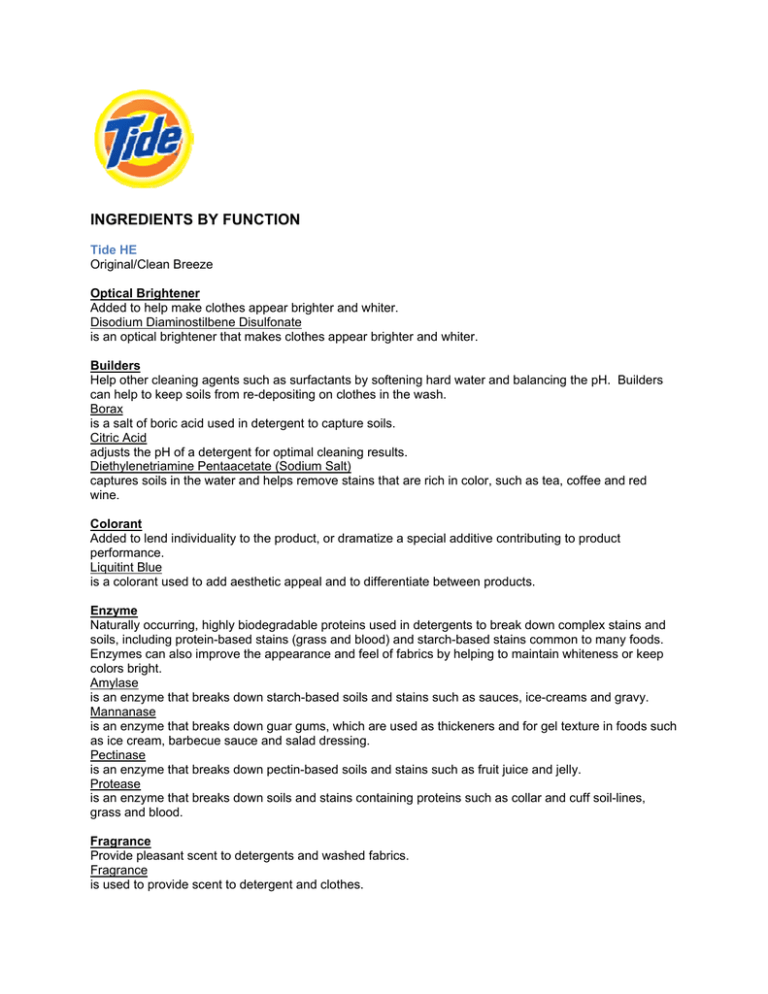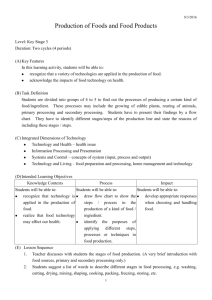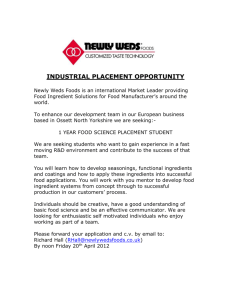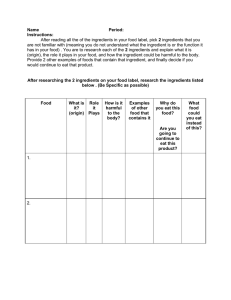ingredients by function
advertisement

INGREDIENTS BY FUNCTION Tide HE Original/Clean Breeze Optical Brightener Added to help make clothes appear brighter and whiter. Disodium Diaminostilbene Disulfonate is an optical brightener that makes clothes appear brighter and whiter. Builders Help other cleaning agents such as surfactants by softening hard water and balancing the pH. Builders can help to keep soils from re-depositing on clothes in the wash. Borax is a salt of boric acid used in detergent to capture soils. Citric Acid adjusts the pH of a detergent for optimal cleaning results. Diethylenetriamine Pentaacetate (Sodium Salt) captures soils in the water and helps remove stains that are rich in color, such as tea, coffee and red wine. Colorant Added to lend individuality to the product, or dramatize a special additive contributing to product performance. Liquitint Blue is a colorant used to add aesthetic appeal and to differentiate between products. Enzyme Naturally occurring, highly biodegradable proteins used in detergents to break down complex stains and soils, including protein-based stains (grass and blood) and starch-based stains common to many foods. Enzymes can also improve the appearance and feel of fabrics by helping to maintain whiteness or keep colors bright. Amylase is an enzyme that breaks down starch-based soils and stains such as sauces, ice-creams and gravy. Mannanase is an enzyme that breaks down guar gums, which are used as thickeners and for gel texture in foods such as ice cream, barbecue sauce and salad dressing. Pectinase is an enzyme that breaks down pectin-based soils and stains such as fruit juice and jelly. Protease is an enzyme that breaks down soils and stains containing proteins such as collar and cuff soil-lines, grass and blood. Fragrance Provide pleasant scent to detergents and washed fabrics. Fragrance is used to provide scent to detergent and clothes. PH Adjustment Added to help vary the pH balance of detergent for optimal cleaning results and performance. Sodium Hydroxide helps adjust the pH balance of detergent for optimal cleaning results. Polymer Used in liquid detergents to form a layer over remaining soils and stain particles, lifting them out of the fabrics. Other polymers help care for your clothes and provide softness. Diquaternium Ethoxy Sulfate is a polymer used in detergent to lift clay soils out of fabrics. Polyethyleneimine Ethoxylate is a polymer used in detergent to lift stains and soils out of fabrics. Process Aid Additive that helps contribute to the performance and efficiency of other ingredients in the product, including stabilization and the prevention of sudsing in the wash. Calcium Formate is the calcium salt of formic acid which helps to stabilize enzymes in the detergent. Diethylene Glycol is a clear, odorless organic liquid used as a solvent to ensure that ingredients are evenly distributed. Dimethicone is a silicon-based organic polymer used to prevent excess sudsing. Ethanol (pure alcohol) is used as a process aid to help keep other ingredients in the product in solution. Ethanolamine is an organic liquid that helps the different types of surfactants remain evenly distributed in a concentrated detergent. Propylene Glycol is a biodegradable, colorless, odorless liquid used in detergents as an enzyme stabilizer and solvent to ensure that ingredients are evenly distributed. Sodium Cumene Sulfonate is a clear liquid used in detergent to improve emulsifying and dispersing functions. It also helps the different types of surfactants remain evenly distributed in the detergent. Sodium Formate is the sodium salt of formic acid used to balance the electrolytes in the detergent. Water is a processing aid added to detergent to help dissolve some of the ingredients. Surfactant Wetting agents that help make liquids spread more easily, and play an important role in extracting stains. Surfactants consist of two parts, which first penetrate and extract stains from fabric. They then suspend those stains in water to help prevent the particles from being re-deposited onto garments in the wash. Alcohol Ethoxylate is a low-foaming surfactant that helps penetrate stains and extract soils. Alcoholethoxy Sulfate is a surfactant that helps penetrate stains, extract soils and suspend stain particles in water to prevent them from being redeposited. It is especially effective in hard water. Laureth-9 is a low-foaming surfactant that helps penetrate stains and extract soils. Linear Alkylbenzene Sulfonate is a general-purpose surfactant that helps penetrate stains, extract soils and suspend stain particles in water to prevent them from being redeposited. Sodium Fatty Acids are familiar to everyone as soap, a natural way to clean many kinds of soils. INGREDIENTS BY PROMINENCE Tide HE ALL SCENTS water alcoholethoxy sulfate linear alkylbenzene sulfonate alcohol ethoxylate citric acid ethanolamine sodium fatty acids diethylene glycol propylene glycol sodium hydroxide borax polyethyleneimine ethoxylate ethanol protease sodium cumene sulfonate diquaternium ethoxysulfate Laureth-9 fragrance amylase DIETHYLENETRIAMINE PENTAACETATE (SODIUM SALT) disodium diaminostilbene disulfonate sodium formate pectinase calcium formate mannanase Liquitint™ Blue dimethicone SAFETY Safety: The Most Important Ingredient in Tide® Ensuring the safety of our Tide® line of fabric care products is a responsibility that P&G takes very seriously. Before any product can appear on store shelves, it must be demonstrated safe to use as directed. But that is only the beginning of our journey. The Earth's resources are limited and valuable, and we have an obligation to future generations to use these resources wisely. P&G Fabric Care scientists use well-established safety assessment methods to evaluate products and the individual ingredients that make up each product. As the science behind the safety of our products continues to evolve, we are developing new, innovative methods to advance safety research. But our assessments go well beyond basic methodology, because as a Company, P&G is committed to “Doing What’s Right”. Our scientists are also consumers, and many use our products in their homes and encourage their family, friends, and members of their community to use our products in their homes. These guiding principles, and the extensive processes behind them, help to reinforce why we know our products are safe when used as directed. Safety Assessment 101: What Is It? Safety Assessment is an interdisciplinary approach, which focuses on the scientific understanding and measurement of ingredients and their possible impact on humans and the environment. Simply put, we use the following equation to understand and quantify that impact: Risk = Hazard x Exposure As we work through these detailed technical assessments, our scientists ask themselves the following questions: • • • • Can the selected ingredient be safely used in this product or application? What could go wrong during the use of this product? What is the right amount of product to use? Is this product safe for consumers and the environment? The answers to these questions help us not only effectively “design in” safety to our products through the careful selection of ingredients, but also help us to educate consumers on the safe and effective use of these products that they use in their homes every day. Safety (or risk) assessment is actually present in the everyday life of every person, and in every profession, even though it may not always be thought of in this way. People in the medical profession, for example, deal with relative risk every day. When they treat a patient with a prescription medication, they have to consider side effects and other risk factors. Likewise, when recommending surgery they have to be reasonably certain that the benefits will outweigh the risks associated with the surgery. Protecting People Protecting our consumers is one of our most important jobs. We want our consumers to use our products in their homes with the complete confidence that they and their families will be safe from any injuries. After all, many of our own families use these products. To that end, we fully-evaluate our products in terms of skin and eye safety, as well as the risks that could be experienced with accidental ingestion of the product. Toxicology is the study of the adverse effects of individual ingredients on living organisms. This science involves an understanding of many aspects of biology and chemistry in order to determine what organs and organ systems may be effected by certain ingredients, and the mechanisms that cause these effects to take place. A decision to use a specific ingredient in our products is based on a Human Health Risk Assessment (HHRA), which considers both the potential adverse effects a ingredient may have (i.e., the potential hazards or human health endpoints), and the amount of the ingredient that is required to cause that effect (i.e., the potential exposure or dose). Understanding this balance allows us to make certain that our products are safe for consumers when used as directed. Protecting our Environment The first step in protecting the environment is understanding the environment. P&G's environmental safety organization helps to develop that understanding and to ensure that our products and ingredients are compatible with the environment, including soil, waterways, and the rest of our ecosystem. P&G was one of the first companies in the world to actively study the impact of consumer product ingredients on the environment. Ensuring the environmental safety of our products continues to be a commitment that P&G takes very seriously. Ecotoxicology is the study of the effects the ingredient may have on plants, animals and bacteria. Decisions to use an ingredient or not are based on Environmental Risk Assessment, which determines the “fate” or outcome of that ingredient within our ecosystem. Packaging and Recycling P&G Fabric Care is committed to the principles of reduce, reuse and recycle. We are working with the recycling industry to encourage our consumer to recycle more of our packages. With complex computerized structural models, we are learning how to reduce the amount of plastic in our detergent bottles without sacrificing their strength and durability. Our Scientists: Who We Are, and What We Do Working together, teams of highly trained scientific experts make sure that P&G covers both human and environmental areas of safety concerns. Procter & Gamble goes to great lengths to ensure the safety of our products and their packages when used as directed, and our operations for our employees, consumers and the environment. We consider this to be a requirement for conducting responsible business, and an essential element of building and maintaining public trust in our products. We carefully evaluate the safety of our products and ingredients before they go to market, using well-established safety assessment methods. P&G employs the same safety standards in every country where we develop, produce and sell our products. P&G also complies with all applicable legal requirements in our markets around the world. As evidence of this commitment, more than 600 Procter & Gamble scientists and technical experts work full-time to ensure the safety and regulatory compliance of our products when used as directed and our operations, represented within 18 countries around the world. Our scientists often work at the edge of environmental and human health safety assessment, and routinely publish their findings in peer-reviewed scientific journals. These individuals work across a variety of disciplines and specialty areas. Our Human Safety Organization The Human Safety Organization employs scientists from diverse fields, including reproductive toxicology, immunology, respiratory toxicology, molecular biology, genotoxicity and carcinogenicity. More recently, genomics is being applied in the various toxicological disciplines in line with the latest trends in the field. P&G's researchers work closely with scientists at universities, governmental bodies and industry organizations to share knowledge and work collaboratively on new and improved methods and approaches to advance the science of toxicology. Because P&G scientists work at the leading edge of toxicology and human health risk assessment, their work and research findings are routinely published in peer-reviewed scientific literature. Our Environmental Safety Organization P&G started the Environmental Safety Organization in the late 1960s, which was located almost exclusively in Cincinnati, Ohio, for 20 years. Today, the organization spans the globe, allowing us to serve and better-understand the many markets in which Procter & Gamble sells and distributes our products around the world. The Environmental Science Organization employs doctoral scientists in diverse fields such as environmental toxicology, microbiology, biodegradation, ecology, environmental engineering, analytical chemistry, microbial ecology, environmental modeling and life cycle assessment. Beyond laboratory research, much of their expertise lies in computer-based applications like exposure modeling, structureactivity relationships (SAR), probabilistic risk assessment and geographical information systems (GIS). Environmental Risk Assessment (ERA) integrates a scientific balance between Environmental Effects Testing (which measures the potential impact of the ingredient on the ecosystem); with Environmental Fate Testing (which evaluates how an ingredient moves through and is integrated into the ecosystem). P&G is widely-regarded and recognized for its innovation and contribution to these methods and processes within the global consumer products industry. Beyond the Store: In Touch and Connected with our Consumers Once P&G scientists have established and documented the safety of the ingredients, a product can be introduced onto the market. The thoroughness of our safety standards and processes is then confirmed by the billions of uses of our products every day that delight our consumers. But, that is only the beginning of our journey. P&G provides a toll-free telephone number on the label or package of all of the products that we market, which users can call to ask questions and share their experiences. P&G personnel responsible for safety monitor these calls to ensure that the experience in the market is as expected. Scientists promptly investigate any alleged safety questions to determine what type of problems may exist and how they should be addressed. This follow-up and commitment provides continuous feedback that enables P&G to maintain a high standard of product quality and consumer satisfaction. This feedback also gives us valuable information on how to develop innovative new products to improve consumers’ lives, now and for generations to come.


